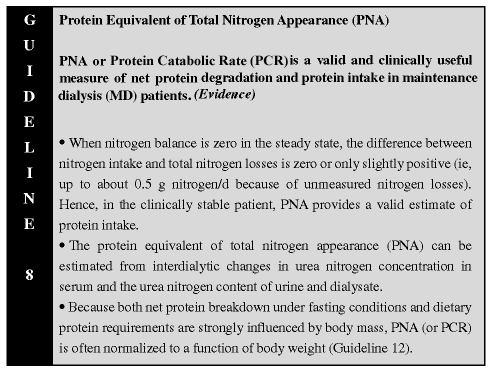
1. Evaluation of Protein-Energy Nutritional Status

During steady-state conditions, nitrogen intake is equal to or slightly greater than nitrogen assessed as total nitrogen appearance (TNA).63 TNA is equal to the sum of dialysate, urine, fecal nitrogen losses, and the postdialysis increment in body urea-nitrogen content. Because the nitrogen content of protein is relatively constant at 16%, the protein equivalent of total nitrogen appearance (PNA) can be estimated by multiplying TNA by 6.25 (PNA is mathematically identical to the protein catabolic rate or PCR). In the clinically stable patient, PNA can be used to estimate protein intake. Because protein requirements are determined primarily by fat-free, edema-free body mass, PNA is usually normalized (nPNA) to some function of body weight (eg, actual, adjusted, or standardized [NHANES II] body weight [SBW] or body weight derived from the urea distribution space [Vurea/0.58]).63 Because urea nitrogen appearance (UNA; ie, the sum of urea nitrogen in urine and dialysate and the change in body urea nitrogen) is highly correlated with TNA and measurement of total nitrogen losses in urine, dialysate, and stool is inconvenient and laborious, regression equations to estimate PNA from measurements of urea nitrogen in serum, urine, and dialysate have been developed. The estimation of PNA from measurements of urea nitrogen is readily performed from the routine urea kinetic modeling session in HD patients and, at least in theory, should be subject to less measurement error than dietary diaries and recall. The equations used to estimate PNA are discussed in Appendix V.
There are several important limitations to PNA as an estimate of DPI. First, PNA approximates protein intake only when the patient is in nitrogen equilibrium (steady-state).63 In the catabolic patient, PNA will exceed protein intake to the extent that there is net degradation and metabolism of endogenous protein pools to form urea. Conversely, when the patient is anabolic (eg, growth in children, recovering from an intercurrent illness, or during the last trimester of pregnancy) dietary protein is utilized for accrual of new body protein pools, and PNA will underestimate actual protein intake. Second, UNA (and hence PNA) changes rapidly following variations in protein intake. Hence, PNA may fluctuate from day to day as a function of protein intake, and a single PNA measurement may not reflect usual protein intakes. Third, when DPI is high, TNA underestimates protein intake (ie, nitrogen balance is unrealistically positive).64,65 This is probably caused by increased nitrogen losses through unmeasured pathways of excretion (eg, respiration and skin).66 Fourth, PNA may overestimate DPI when the protein intake is less than 1 g/kg/d (possibly due to endogenous protein catabolism).67-69 Finally, normalizing PNA to body weight can be misleading in obese, malnourished, and edematous patients. Therefore, it is recommended that for individuals who are less than 90% or greater than 115% of SBW, the adjusted edema-free body weight (aBWef) be used when normalizing PNA to body weight (Guideline 12).
Notwithstanding these limitations, when consideration is given to the caveats discussed above, the nPNA is a valid and useful method for estimating protein intake. However, PNA should not be used to evaluate nutritional status in isolation, but rather as one of several independent measures when evaluating nutritional status.